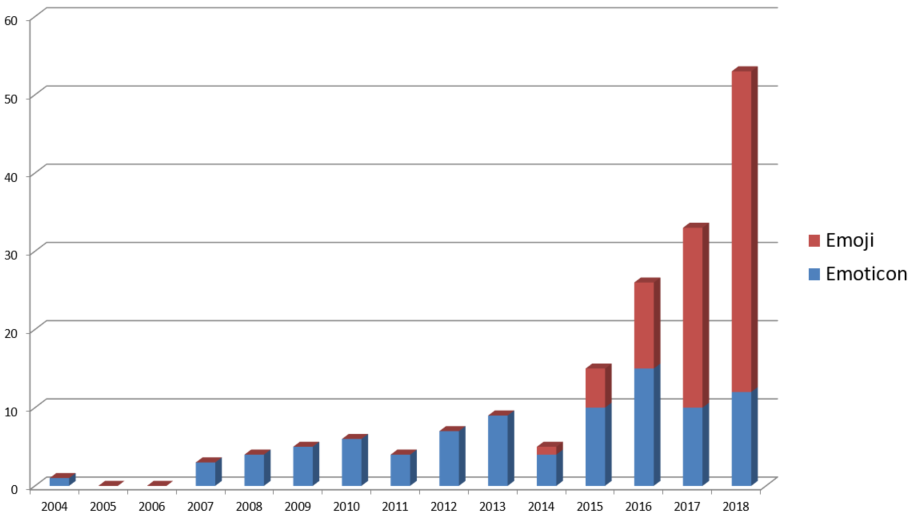eDiscovery Daily Blog
Emoji Are Showing Up in Court Cases More and More: eDiscovery Trends
Without a doubt, our forms of communication are continuing to evolve from just email and we now have to add social media, text messaging and other messaging apps as forms of communication that need to be routinely preserved, collected, processed, reviewed and produced. But, it’s not just the forms of communication that are changing, it’s the way we communicate that is changing as well. So, you may or may not be surprised that emoji (yes, the plural of “emoji” is still “emoji”, at least officially) are showing up in court cases exponentially.
As discussed in The Verge (Emoji are showing up in court cases exponentially, and courts aren’t prepared, written by Dani Lee), emoji are showing up as evidence in court more frequently with each passing year. Between 2004 and 2019, there was an exponential rise in emoji and emoticon references in US court opinions, with over 30 percent of all cases (53 out of 171 all time) appearing in 2018, according to Santa Clara University law professor Eric Goldman, who has been tracking all of the references to “emoji” and “emoticon” that show up in US court opinions. Yes, there’s a guy who tracks that stuff! Here’s a chart from Goldman, showing the rise of cases since 2004:

By the way, you do know the difference between an emoji and an emoticon, right? An emoticon is created out of text, primarily via the use of punctuation marks, whereas an emoji is a small image, a pictograph. Nearly everyone has used an emoji and emoticon at least once in their lives, even if they didn’t know what it was called. Personally, I’m not a big fan of emoticons… ;o)
Goldman has written extensively on the subject of “emoji law” – including his blog post Emoji Law 2018 Year-in-Review and his paper published last year titled Emojis and the Law.
So far, the emoji and emoticons have rarely been important enough to sway the direction of a case, but as they become more common, the ambiguity in how emoji are displayed and what we interpret emoji to mean could become a larger issue for courts to contend with. Want a couple of examples? Here you go:
- Bay Area prosecutors were trying to prove that a man arrested during a prostitution sting was guilty of pimping charges, and among the evidence was a series of Instagram DMs he’d allegedly sent to a woman. One read: “Teamwork make the dream work” with high heels and money bag emoji placed at the end. Prosecutors said the message implied a working relationship between the two of them. The defendant said it could mean he was trying to strike up a romantic relationship. Another message from the defendant included the crown emoji, which was said to signify that the “pimp is the king.”
- In 2017, a couple in Israel was charged thousands of dollars in fees after a court ruled that their use of emoji to a landlord signaled an intent to rent his apartment. After sending an enthusiastic text confirming that they wanted the apartment, which contained a string of emoji including a champagne bottle, a squirrel, and a comet, they stopped responding to the landlord’s texts and went on to rent a different apartment. The court declared that the couple acted in bad faith, ruling that the “icons conveyed great optimism” that “naturally led to the Plaintiff’s great reliance on the Defendants’ desire to rent his apartment,” according to Room 404.
Still, it’s rare for cases to turn on the interpretations of emoji. “They show up as evidence, the courts have to acknowledge their existence, but often they’re immaterial,” Goldman says. “That’s why many judges decide to say ‘emoji omitted’ because they don’t think it’s relevant to the case at all.” But emoji are a critical part of communication, and in cases where transcripts of online communication are being read to the jury, they need to be characterized as well instead of being skipped over. “You could imagine if you got a winky face following the text sentence, you’re going to read that sentence very differently than without the winky face,” he says. In the “pimp” case above, the ruling didn’t ultimately hinge on the interpretation of emoji, but they still provided evidentiary support.
Nonetheless, as Craig Ball has noted in several presentations that I’ve seen, the handling of emoji and emoticons will become increasingly important in discovery over time. And, here’s one more challenge to leave you with – emoji often render differently across platforms, so the emoji you see may not be the emoji your audience sees in social media posts or text/other messages. We may have to consult those Egyptian hieroglyphics textbooks soon to see how they managed to communicate thousands of years ago!
So, what do you think? Are you surprised that emoji and emoticons are becoming an increasing part of legal cases? Please share any comments you might have or if you’d like to know more about a particular topic.
Sponsor: This blog is sponsored by CloudNine, which is a data and legal discovery technology company with proven expertise in simplifying and automating the discovery of data for audits, investigations, and litigation. Used by legal and business customers worldwide including more than 50 of the top 250 Am Law firms and many of the world’s leading corporations, CloudNine’s eDiscovery automation software and services help customers gain insight and intelligence on electronic data.
Disclaimer: The views represented herein are exclusively the views of the author, and do not necessarily represent the views held by CloudNine. eDiscovery Daily is made available by CloudNine solely for educational purposes to provide general information about general eDiscovery principles and not to provide specific legal advice applicable to any particular circumstance. eDiscovery Daily should not be used as a substitute for competent legal advice from a lawyer you have retained and who has agreed to represent you.

